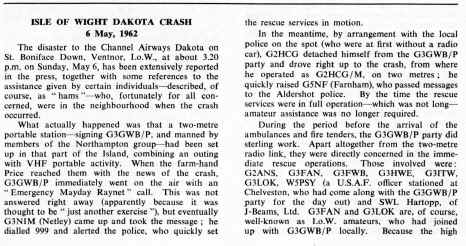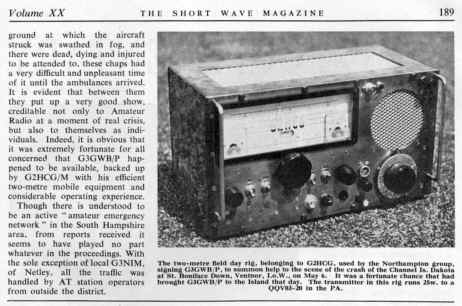
Radio Information
RADIO HAMS SAVE THE DAY!
A VERY DIFFERENT VIEW OF MAY 6TH.
The amateur radio set that was used to transmit the SOS message from the top of the Island. The speed of response and common sense shown by operators and listeners on both sides of the Solent enabled the emergency services to be on site in a few minutes.
This 2m field day rig, belonging to G2HCG was used by the Northampton Group, signing
G3GWB/P to summon help to the scene of the crash of the Channel Is. Dakota at St.
Boniface Down, Ventnor, IoW on May 6th. It was a fortunate chance that had brought
G3GWB/P to the Island that day. The transmitter in this rig runs 25W to a QQV03-
++++++Copy from 1962 Begin++++++
Isle of Wight Dakota Crash
6 May 1962
The disaster to the Channel Airways Dakota on St. Boniface Down, Ventnor, IoW at
about 3.20pm on Sunday May 6 has been extensively reported in the press, together
with some references to the assistance given by certain individuals, described, of
course, as 'hams' -
What actually happened was that a 2m portable station -
In the meantime, by arrangement with the local police on the spot (who were at first
without a radio car), G2HCG detached himself from the G3GWB/P party and drove right
up to the crash, from where he operated as G2HCG/M on 2m, he quickly raised G5NF
(Farnham) who passed messages to the Aldershot police. By the time the rescue services
were in full operation -
During the period before the arrival of the ambulances and fire tenders, the G3GWB/P
party did sterling work. Apart altogether from the 2m radio link, they were directly
concerned in the immediate rescue operations. Those involved were G2ANS, G3FAN, G3FWB,
G3HWE, G3ITW, G3LOK, W5PSY (a USAF officer stationed at Chelveston who had come along
with the G3GWB/P party for the day out) and SWL Hartopp, of J-
It is evident that between them they put up a very good show, creditable not only to Amateur Radio at a moment of real crisis, but also to themselves as individuals. Indeed it is obvious that it was extremely fortunate for all concerned that G3GWB/P happened to be available, backed up by G2HCG/M with his efficient 2m mobile equipment and considerable operating experience.
Though there is understood to be an active ' amateur emergency network' in the South Hampshire area, from reports received, it seems to have played no part whatever in the proceedings. With the sole exception of local G3NIM of Netley, all the traffic was handled by AT station operators from outside the district.
This piece was featured in Short Wave Magazine June, 1962 -
We have edited it very slightly in keeping with the rest of the site.
Our thanks to Kevin Nice, Editor, Short Wave Magazine
Kevin did a massive search through his back copies for this unique view of the accident. Thank you!
Meanwhile, after an intensive search, Roger Bunney managed to dig out an actual copy of the original publication ....



| Instruments |
| Visibility |
| Navigation |
| An Alternative Theory |
| Pressure On Crews |
| Blame |